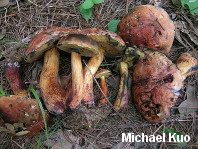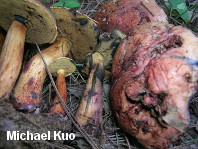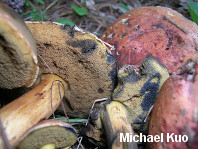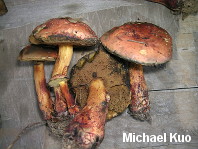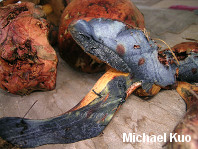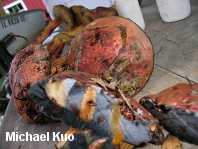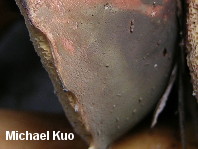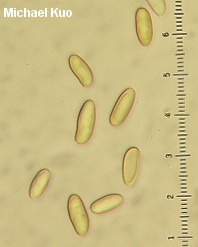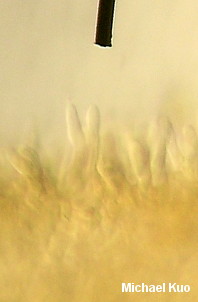| Major Groups > Boletes > Red-Capped, Blue Staining > Boletus carminipes |

|
Boletus sensibilis [ Basidiomycota > Boletales > Boletaceae > Boletus . . . ] by Michael Kuo This species is so frequently debated, misunderstood, and unnecessarily complicated that returning to Charles Peck's original description (1880) goes a long way toward clearing things up. Boletus sensibilis is one of many North American red-capped, blue-staining boletes, but Peck named it "sensibilis" (sensitive) because of "the ease and rapidity" of the blue bruising. "Merely handling the specimens," he wrote, "produces the blue color where they are pressed by the fingers." So, Point Number One: the species bruises blue so readily that the phenomenon is notable and, in Peck's opinion, worthy of the species' very name. Point Number Two: Peck says the stem is "lemon yellow" but that it is "often stained with red or rhubarb-color." He is very clear about the stem's colors, and he does not say that the stem is red, with a yellow apex--like the stem of Boletus bicolor, which he also named (1872), and which he characterized as having a "dark red" stem that was "sometimes yellow at the top." Point Number Three: Peck mentions nothing about an odor for Boletus sensibilis. And it is not as though Peck's sniffer was out of whack; he is the same mycologist who also named Agaricus odoratus (1872; "odor resembling that of the 'poison elder'") and Peziza odorata (1896; with "a peculiar fungoid odor suggestive of that of chestnut blossoms"). The mistakes I am attempting to correct with these points are the popular misconceptions that Boletus sensibilis has to smell like curry, that similar species do not, that merely bruising blue more eagerly than "faintly" qualifies as notable and name-worthy bruising, and, finally, that Boletus sensibilis can have a red stem with a yellow apex. These mistakes lead to mislabeling curry-scented, moderately bruising specimens of Boletus bicolor as Boletus sensibilis--and they create confusion with a third species, named nearly a hundred years later (Smith & Thiers, 1971), Boletus pseudosensibilis. Smith and Thiers did not explain whether they meant to name their species "pseudo-sensitive" (meaning, perhaps, that it bruises but not as strongly as Boletus sensibilis)--or something more like "pseudo-Boletus sensibilis" (perhaps indicating that the species appears like Boletus sensibilis but on closer inspection is different). But for identification purposes, Boletus pseudosensibilis can be easily separated on the basis of its browner cap, less eager bruising, the cap surface's green flash in reaction to ammonia, and the microscopic structure of its cap surface. Two under-emphasized features of Boletus sensibilis that also help to separate it from its cousins are the fact that its tube layer is "normal" for a bolete, and not proportionally shallow--and the fact that the mature pore surface turns dingy orangish-brownish, rather than olive yellow. See the key to red-capped, blue-staining boletes and the printable comparison table for three often-confused boletes for further discussion and help with identification. Description: Ecology: Mycorrhizal with hardwoods--especially oaks and beech; growing scattered or gregariously; summer and fall; possibly widely distributed east of the Rocky Mountains. The illustrated and described collection is from Illinois. Cap: 5-12 cm, convex when young, becoming broadly convex; dry; finely velvety when young, but soon bald; dirty pinkish red to darker orangish red, fading to reddish cinnamon; bruising blue promptly and strongly. Pore Surface: Yellow at first, becoming dull orangish-brownish, with olive hints, at maturity; bruising dark blue instantly; with 2-3 angular pores per mm at maturity; tubes 10-15 mm deep at maturity. Stem: 5-13 cm long; 2-3.5 cm thick; gracefully club-shaped; bald; yellow to orangish yellow or brownish yellow, developing reddish streaks and areas over the basal half; bruising dark blue instantly when handled; eventually sordid orangish overall; not reticulate, or with a fine reticulum near the apex; basal mycelium whitish. Flesh: Yellow in cap and stem; staining instantly dark blue when sliced. As noted by Smith & Thiers (1971), the flesh of dried specimens from the herbarium, when sectioned and moistened in alcohol followed by water, bruises blue all over again, even bluing the water and the paper towel used for blotting. Odor and Taste: Odor not distinctive, or, often, curry-like; taste not distinctive. The illustrated collection did not have a distinctive odor when fresh, but smells like curry as dried, six years later. Chemical Reactions: Ammonia negative on cap surface, erasing blue to greenish on flesh. KOH gray on cap surface; erasing blue to dull orange on flesh. Iron salts gray on cap surface; negative to orangish on flesh. Spore Print: Grayish olive. Microscopic Features: Spores 10-15 x 4-5 µ; subfusiform; smooth; yellow or golden in KOH. Hymenial cystidia narrowly fusiform; to about REFERENCES: Peck, 1880. (Saccardo, 1891; Smith & Thiers, 1971; Grund & Harrison, 1976; Smith, Smith & Weber, 1981; Phillips, 1991/2005; Metzler & Metzler, 1992; Both, 1993; Bessette, Roody & Bessette, 2000; Binion et al., 2008.) Herb. Kuo 07210901. This site contains no information about the edibility or toxicity of mushrooms. |
© MushroomExpert.Com |
|
Cite this page as: Kuo, M. (2015, January). Boletus sensibilis. Retrieved from the MushroomExpert.Com Web site: http://www.mushroomexpert.com/boletus_sensibilis.html |
